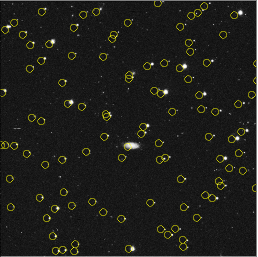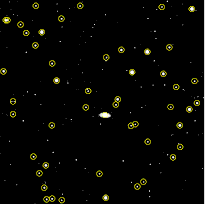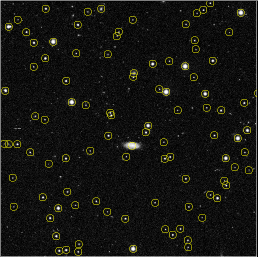|
| Using the USNO-B1.0 CatalogEven if an image has enough HST Guide Stars in them to fit a world coordinate system, it is usually better to use more stars, and the US Naval Observatory B1.0 Catalog has more than half a billion of them. |

Click on image for larger version |
This FITS image
contains a galaxy whose coordinates we want to find.
The header keywords
NAXIS = 2 NAXIS1 = 1024 NAXIS2 = 1024 RA = '16:15:56.0' DEC = '31:25:10' EPOCH = 2000.0 SECPIX = 0.652provide a nominal WCS which is used at the left by imub1 to plot the catalog over the image. That WCS is also used by imwcs as an initial value. |
To quickly find the 100 brightest stars in the image, Emmanuel Bertin's
SExtractor program was used:
$ sex test.fits Frame: "16139p3131R" / 1024 x 1024 / 16 bits INTEGER data Background: -0.17547 RMS: 9.83951 / Threshold: 14.7593 Objects: detected 504 / sextracted 503 > All done $ sort -n +2.0 image.sex | head -100 > test.sex |

Click on image for larger version |
$ imwcs -d test.sex -c ub1 -h 50 test.fitsThe verbose mode gives more information about how the fit is going:
$ imwcs -vd test.sex -c ub1 -h 50 test.fits

Click on image for larger version |
The
final FITS image
contains standard FITS world coordinate system keywords and
a logging keyword showing what version of imwcs fit the WCS:
CRPIX1 = 514.5519 CRPIX2 = 514.0039 CD1_1 = -0.000178918 CD1_2 = 0.000000559 CD2_1 = 0.000000285 CD2_2 = 0.000178708 WCSRFCAT= 'ub1 ' WCSIMCAT= 'testx90m.sex' WCSMATCH= 83 WCSNREF = 100 WCSTOL = 2.5000 RA = '16:15:56.711' DEC = '+31:25:07.74' WEQUINOX= 2000 EPOCH = 2000 RADECSYS= 'FK5 ' CTYPE1 = 'RA---TAN' CTYPE2 = 'DEC--TAN' CRVAL1 = 243.986294732 CRVAL2 = 31.418816405 SECPIX1 = 0.6441 SECPIX2 = 0.6434 WCSSEP = 0.187 EQUINOX = 2000 IMWCS = '3.3.0, 29 January 2003, Doug Mink (dmink@cfa.harvard.edu)' |
![[Telescope Data Center]](http://tdc-www.harvard.edu/images/tdci.gif)